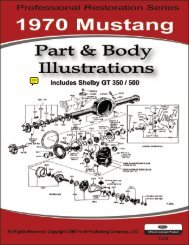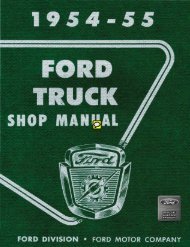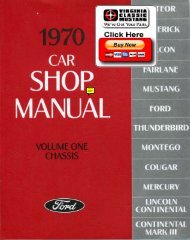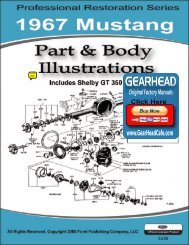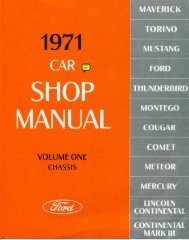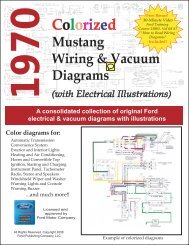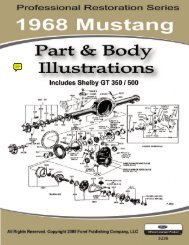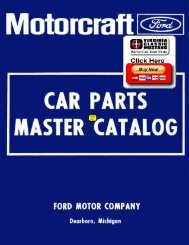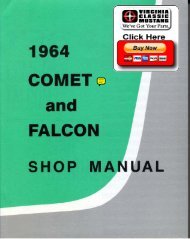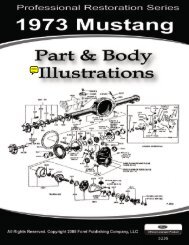DEMO - 1965 Ford Truck Shop Manual - ForelPublishing.com
DEMO - 1965 Ford Truck Shop Manual - ForelPublishing.com
DEMO - 1965 Ford Truck Shop Manual - ForelPublishing.com
You also want an ePaper? Increase the reach of your titles
YUMPU automatically turns print PDFs into web optimized ePapers that Google loves.
2-56 GROUP 2 - BRAKES<br />
ASSEMBLY RING<br />
FIG. 37-Assembly Ring<br />
Removal<br />
RUBBER STOPPER<br />
H1025-A<br />
14. Carefully guide the hydraulic<br />
cylinder over the lip of the piston<br />
cup, and thread the hydraulic cylinder<br />
into the end plate, finger-tight.<br />
Remove the hook clamps and remove<br />
the unit from the vise.<br />
15. Hold a 6 3 A -inch booster body<br />
in a vertical position, and mount it<br />
in a vise at the control tube. Mount<br />
the 9V^-inch unit in the vise at the<br />
guide tube nut.<br />
16. Insert a rubber stopper into<br />
the control tube (Fig. 37).<br />
17. With the top face of the vacuum<br />
piston flush with the top edge<br />
of the assembly ring, line up the<br />
assembly ring with the booster body,<br />
and guide the vacuum piston into the<br />
booster body. (On 9^-inch units, if<br />
the vacuum piston is permitted to tip<br />
slightly, the vacuum piston guide will<br />
not enter the guide tube.)<br />
18. As soon as the piston has entered<br />
the booster body (the guide has<br />
entered the guide tube—Wi -inch), lift<br />
the assembly ring to permit inspection<br />
of the piston packing. If the<br />
leather packing has started to enter<br />
the booster body without any part of<br />
the packing folded back, remove the<br />
rubber stopper, press the vacuum piston<br />
into the booster body approximately<br />
2 inches, and replace the rubber<br />
stopper. If inspection reveals that<br />
any part of the piston packing has<br />
been folded back, repeat the above<br />
operation.<br />
19. With the rubber stopper still<br />
in the control line tube, slide the<br />
assembly ring over the end plate, as<br />
shown in Fig. 37, and remove the<br />
rubber stopper from the control line.<br />
20. Assemble a new rubber gasket<br />
in the groove of the end plate,<br />
and align the end plate with the<br />
booster body at the scribe marks. Install<br />
the hook bolts and tighten uniformly<br />
(Fig. 30).<br />
21. Drop the two hose clamps<br />
over the control tube on the booster<br />
body and assemble the hose on the<br />
control tube. If the control valve<br />
body on a 6 3 A -inch unit is being replaced,<br />
transfer the removable control<br />
tube from the old to the new<br />
body.<br />
22. The use of guide pins, threaded<br />
into the end plate, will simplify<br />
the assembly of the control valve<br />
body and <strong>com</strong>ponents to the end<br />
plate, and will reduce the possibility<br />
of damaging the diaphragm during<br />
assembly. Guide pins may be made<br />
by cutting the heads from five 32 x<br />
2Vi-inch machine screws.<br />
Install the guide pins, position a<br />
new gasket and the diaphragm over<br />
the pins, then position the return<br />
spring in the recess of the diaphragm<br />
(Figs. 30 and 31).<br />
23. Assemble the control valve<br />
body over the pins so that the control<br />
tube on the valve body enters<br />
the hose on the booster body tube.<br />
Hold the control valve body and<br />
parts against the end plate, and remove<br />
one guide pin at a time, replacing<br />
it with a screw and lock<br />
washer. Tighten the screws securely.<br />
24. Secure the hose clamps in position.<br />
25. Install the spring, the seal, and<br />
the air inlet tube and cover assembly<br />
to the control valve body and secure<br />
in place with the snap ring. (Figs. 30<br />
and 31.)<br />
26. Align the bleeder screw in the<br />
end cap with the bleeder screw in<br />
the end plate by manually turning the<br />
hydraulic cylinder in the end plate<br />
threads. While holding the hydraulic<br />
cylinder in this properly aligned position,<br />
securely tighten the cylinder<br />
lock nut (Figs. 30 and 31).<br />
27. Make sure that all bolts, nuts,<br />
washers, and screws are in place and<br />
securely tightened.<br />
BENDIX (HYDROVAC) BOOSTER<br />
TANDEM PISTON TYPE<br />
DISASSEMBLY<br />
1. Disconnect the hydraulic and<br />
vacuum by-pass tubes from the control<br />
valve body, remove the air inlet<br />
retainer, and remove the air inlet<br />
fitting, gasket, and spring from the<br />
control valve body.<br />
2. Remove the screws retaining<br />
the control valve body to the end<br />
plate, and remove the control valve<br />
body spring, gasket and diaphragm<br />
from the rear end plate (Fig. 38).<br />
3. Remove the retaining nut, remove<br />
the small and large atmospheric<br />
valves, and the vacuum valve<br />
from the control valve body.<br />
4. Loosen the hydraulic cylinder<br />
lock nut, and remove the hydraulic<br />
cylinder and seal (Fig. 38).<br />
5. Install the booster assembly in<br />
an arbor press and insert a brass drift<br />
through the atmospheric port in the<br />
rear end plate. Press the vacuum cyl-<br />
BY-PASS TUBE<br />
LOCATION<br />
(HYDRAULIC) (VACUUM)<br />
DIAPHRAGM<br />
HYDRAULIC<br />
CYLINDER<br />
CAP<br />
RETAINER<br />
ATMOSPHERIC<br />
VALVES<br />
(SMALL) (LARGE)<br />
AIR INLET<br />
FITTING<br />
GASKET<br />
VACUUM<br />
NUT / VALVE<br />
CONTROL<br />
VALVE BODY<br />
FIG. 38—Tandem Piston-Type Vacuum Booster<br />
GASKET<br />
END PLATE<br />
(REAR)<br />
RETAINER<br />
PIN<br />
H1026-A




